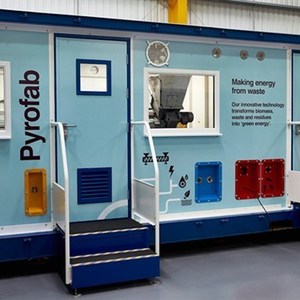Aston University bioenergy technology embarks on European tour




Aston University
July 29, 2015
BY Aston University
Pre-testing of waste materials using prototype Pyrofab technology was recently underway ahead of a summer tour to evaluate sustainable sources of bioenergy from waste across north-west Europe. The Pyrofab is based on Pyroformer technology, developed in the U.K. by the European Bioenergy Research Institute at Aston University. Using this intermediate pyrolysis process, the tests are determining the potential of different waste materials and residues to be processed into low carbon fuel.
The Pyrofab converts carbon from organic waste materials to produce carbon-neutral fuel and biochar, a commodity that can be used to improve soil. It has the ability to process a wide range of biomass, residues and wastes. This means that hard to treat sources of waste now have the potential to be used as a feedstock to produce low carbon energy. Feedstocks being tested include food waste, domestic waste, agricultural waste such as pig manure, industrial waste and even baby wipes.
The Pyrofab is compact, transportable and can work with existing generation technology. This means waste can be locally sourced, reducing the environmental impact of transportation and reliance on overseas imports of biomass such as wood. It encourages energy diversity, helping to protect Europe’s energy supply. What’s more, bioenergy generation isn’t intermittent like other renewables.
Advertisement
Advertisement
When fully developed the Pyrofab will offer businesses and local authorities access to the emerging bioenergy market, stimulating rural economies and reducing waste management costs. The bioenergy market in the U.K. alone is expected to be worth £12 billion ($18.72 billion) in the next decade, and demand for bioenergy is expected to increase by 49 per cent between 2012 and 2040. According to the European Commission bioenergy could account for up to two thirds of its target to generate 27 percent of energy from renewable sources by 2030.
Pyrofab prototypes are set to tour four sites in North West Europe, hosted by partners in an EU INTERREG IVB funded project—BioenNW—and will then return to the U.K. The Pyrofab system consists of two parts, a conversion technology containing a Pyroforme which uses intermediate pyrolysis to convert waste materials into products, and a monitoring lab and results analysis facility. Each part is small enough to fit into a single shipping container.
Results from pre-testing work that has taken place at EBRI (lead partner of BioenNW) and the tour itself will be included in BioenNW’s business support tool, designed to help businesses make bioenergy investment decisions. The tool if part of BioenNW’s work funded by the European Union to support companies, organisations and local authorities to deliver local bioenergy.
Professor Tony Bridgwater, Director of the European Bioenergy Research Institute at Aston University, said, “When you think about our future energy security and sustainability, baby wipes and leftovers might not be the first things that spring to mind. Through the BioenNW project, partners are using EBRI developed technology to put waste at the forefront of the race to meet Europe’s biggest energy challenges.”
Advertisement
Advertisement
“The Pyrofab unlocks the potential of waste, producing sustainable carbon neutral bioenergy and biofuels. This has the potential to change a significant liability for businesses and local authorities across North West Europe into a home grown resource, to reduce waste management costs and generate new revenue streams through the derived products.”
“It could also play a significant part in delivering Europe’s environmental targets and improve energy security; making use of our own resources to reduce the need for imports.”
Related Stories
The U.S. Department of Energy Bioenergy Technologies Office (BETO) announced up to $23 million in funding to support research and development (R&D) of domestic chemicals and fuels from biomass and waste resources.
The U.S. DOE has announced its intent to issue funding to support high-impact research and development (R&D) projects in two priority areas: sustainable propane and renewable chemicals and algal system cultivation and preprocessing.
Sens. Sherrod Brown, D-Ohio, and Pete Ricketts, R-Neb., in August introduced the Renewable Chemicals Act, a bill that aims to create a tax credit to support the production of biobased chemicals.
The Chemical Catalysis for Bioenergy Consortium, a consortium of the U.S. DOE’s Bioenergy Technologies Office, has launched an effort that aims to gather community input on the development of new biomass processing facilities.
USDA on March 8 celebrated the second annual National Biobased Products Day, a celebration to raise public awareness of biobased products, their benefits and their contributions to the U.S. economy and rural communities.
Upcoming Events










